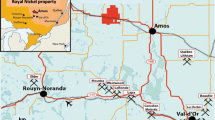Abstract
Using a series of analytical and experimental methods, a predictive estimate was obtained for the possible environmental impact of the waste rocks of the Veduginskoe gold deposit. All samples of the country rocks were analyzed for major and 13 trace elements. This allowed us to demonstrate that the accumulation of elements in the water phase (water and weak acid extracts) is not always correlated with their contents in the solid material but controlled by their chemical speciation in the water-rock system. The dynamics of 20-week leaching of a series of contrasting rock samples supported the plausibility of criteria selected for their differentiation: the filtrates of one group remained neutral to weakly alkaline up to the end of experiments, whereas an “acid mine drainage” was produced in the other group. Acid sulfate solution with high contents of Fe, Al, and heavy metals can also accumulate Be, As, and Hg. However, the slightly alkaline solutions that have not received proper attention during environmental protection operations may transport elements with specified maximum permissible concentrations (MPC): anion-forming Sb, As, and Mo; amphoteric Be; and supertoxic Hg.
Similar content being viewed by others
References
R. Allan, “Introduction: Sustainable in the Future,” J. Geochem. Explor. 52, 1–4 (1995).
W. Salomons, “Environmental Impact of Metals Derived from Mining Activities: Processes, Predictions, Preventions,” J. Geochem. Explor. 52, 5–23 (1995).
S. B. Bortnikova, O. L. Gaskova, and E. P. Bessonova, Geochemistry of Anthropogenic Systems (Sib. Otd. Ross. Akad. Nauk, Fil. GEO, Novosibirsk, 2006) [in Russian].
K. Fukushi, M. Sasaki, T. Sato, et al., “A Natural Attenuation of Arsenic in Drainage from an Abandoned Arsenic Mine Dump,” Appl. Geochem. 18, 1267–1278 (2003).
O. L. Gaskova and S. B. Bortnikova, “Estimation of Acid-Basic Potential of the Rocks as the First Step to Prediction of Geoecological Situation,” Vestn. Otd. Nauk Zemle Ross. Akad. Nauk, No. 1(24), (2006). URL: http:/www.scgis.ru/Russian/cp1251/h-dgggms/1-2006/informbul-1-2006/geoecol-7.pdf http:/www.scgis.ru/Russian/cp1251/h-dgggms/1-2006/informbul-1-2006/geoecol-7.pdf" Key=".
S. B. Bortnikova, O. L. Gaskova, and N. V. Yurkevich, “Predictive Model of Drainage-Waste Heap Interaction: Preventive Estimation of Potential Risk,” Vestn. Otd. Nauk Zemle Ross. Akad. Nauk, No. 1(24), (2006). URL: http:/www.scgis.ru/Russian/cp1251/h-dgggms/1-2006/informbul-1-2006/geoecol-6.pdf http:/www.scgis.ru/Russian/cp1251/h-dgggms/1-2006/informbul-1-2006/geoecol-6.pdf .
A. Genkin, Yu. Safonov, and Yu. Min’kin, “Paragenetic Association and the Mode of Occurrence of Gold in Refractory Ores,” in Proceedings of 9th Symposium of International Association on the Genesis of Ore Deposits, Beijing, China, 1994 (Beijing, 1994), pp. 130–131.
N. F. Vasil’ev and A. A. Storozhenko, “Metallogenic Zoning and Predictive Estimation of a Territory in the Course of GDP-200 by the Example of Sheet O-46IV,” in Proceedings of 7th All-Russian Seminar on Computer Support of State Program State Geological Map-200, Essentuki, Russia, 2000 (YURGTU, Novocherkassk, 2000), pp. 139–145 [in Russian].
V. B. Baryshev, Yu. P. Kolmogorov, G. N. Kulipanov, and A. N. Skrinskii, “X-Ray Fluorescence Element Analysis Using Synchrotron Radiation,” Zh. Anal. Khim. 41(3), 389–401 (1986).
A. A. Sobek, W. A. Schuller, J. R. Freeman, and R. M. Smith, Field and Laboratory Methods Applicable to Overburden and Minesoils, U.S. EPA, 600/2-78-054 (1978).
A. Tessier, P. G. C. Cambell, and M. Bisson, “Sequential Extraction Procedure for the Speciation of Particulate Trace Metals,” Anal. Chem. 51(7), 256–273 (1979).
Technique for the Measurement of the Weight Fraction of Water Soluble Species of Metals (Copper, Lead, Zinc, Nickel, Cadmium, Cobalt, Chromium, Manganese) in Soil Samples Using Atomic Absorption. RD 52.18.286-91 (Gos. Kom. Gidrometeorol., Moscow, 1991) [in Russian].
Sanitary Norms SanPiN 42-128-4433-87“Sanitary Norms for the Maximum Permissible Concentrations of Chemical Substances in Soil” (Approved by the Chief State Sanitary Doctor of the USSR on October 30, 1987, No. 4433-87). All-Union Sanitary-Hygienic and Sanitary-Antiepidemic Rules and Norms
S. B. Bortnikova, O. L. Gaskova, and A. A. Airiyants, Anthropogenic Lakes: Formation, Evolution, and Environmental Influence (Sib. Otd. Ross. Akad. Nauk, Fil. GEO, Novosibirsk, 2003) [in Russian].
O. L. Gaskova and S. B. Bortnikova, “On the Quantitative Evaluation of the Neutralizing Potential of Host Rocks,” Geokhimiya, No. 4, 461–464 (2007) [Geochem. Int. 45, 409–412 (2007)].
ASTM (American Society for Testing and Materials) D 5744-96[1]. Standard Test Method for Accelerated Weathering of Solid Materials Using a Modified Humidity Cells (ASTM, Philadelphia, 2001).
A. P. Vinogradov, “Average Content of Chemical Elements in Major Igneous Rocks of the Earth’s Crust,” Geokhimiya, No. 7, 555–571 (1962).
K. K. Turekian and K. H. Wedepohl, “Distribution of the Elements in Some Major Units of the Earth Crust,” Geol. Soc. Am. Bull. 72, 175–192 (1961).
A. D. Kanishchev and G. I. Menaker, “Average Contents of 15 Ore-Forming Chemical Elements in the Earth’s Crust of Transbaikalia,” Geokhimiya, No. 2, 187–202 (1974).
Maximum Permissible Concentration (MPC) of Chemical Compounds in Water of Potable-Economic and Cultural-Domestic Use. GN 2.1.5.1315-03.
S. R. Krainov and V. M. Shvets, Hydrogeochemistry (Nedra, Moscow, 1992) [in Russian].
O. L. Gaskova, E. P. Bessonova, and S. B. Bortnikova, “Leaching Experiments on Trace Element Release from the Arsenic-Bearing Tailings of Khovu-Aksy (Tuva Republic, Russia),” Appl. Geochem. 18, 1361–1371 (2003).
O. L. Gaskova, S. B. Bortnikova, A. A. Airiyants, Yu. P. Kolmogorov, and M. V. Pashkov, “Geochemical Features of an Anthropogenic Impoundment with Cyanidation Wastes of Gold-Arsenopyrite-Quartz Ores,” Geokhi-miya, No. 3, 317–328 (2000) [Geochem. Int. 38, 281–291 (2000)].
Author information
Authors and Affiliations
Corresponding author
Additional information
Original Russian Text © S.B. Bortnikova, O.L. Gas’kova, N.A. Prisekina, 2010, published in Geokhimiya, 2010, Vol. 48, No. 3, pp. 295–310.
Rights and permissions
About this article
Cite this article
Bortnikova, S.B., Gas’kova, O.L. & Prisekina, N.A. Geochemical estimation of the potential danger of waste rocks from the Veduginskoe deposit. Geochem. Int. 48, 280–294 (2010). https://doi.org/10.1134/S0016702910030055
Received:
Published:
Issue Date:
DOI: https://doi.org/10.1134/S0016702910030055




